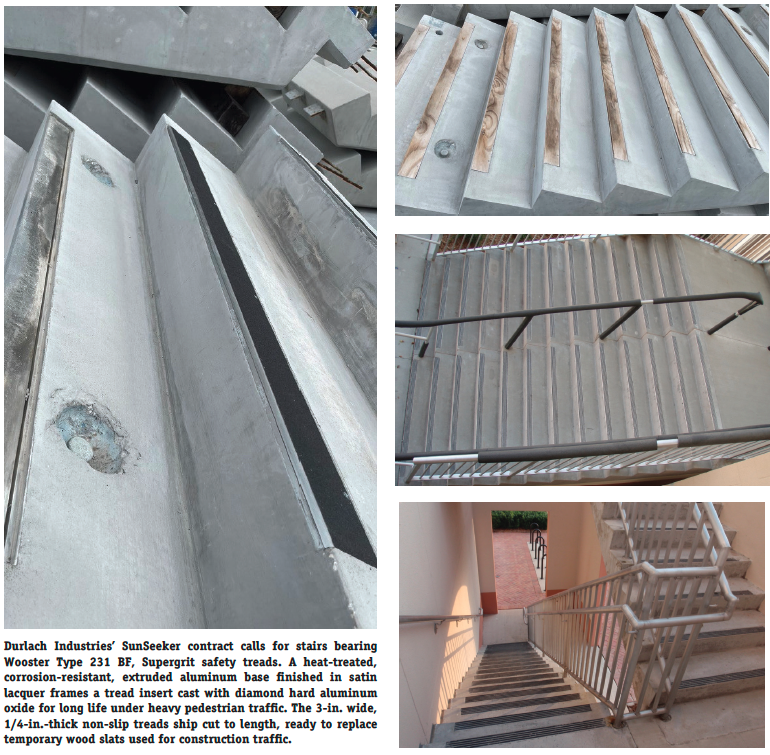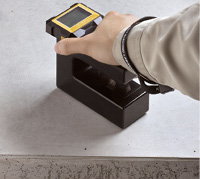Palmetto, Fla.-based Durlach Industries has specialized in precast stairs and landings for 20-plus years, shipping product up and down the East Coast. Leading its current project roster is SunSeeker in Port Charlotte, Fla., a prime example of the producer’s fabrication capabilities and time-saving approach to construction schedules. The resort will feature approximately 500 hotel rooms, 180-plus extended stay suites, 55,000 square feet of meeting and conference space, 19 restaurants and bars, and retail outlets along a scenic harbor walk.
Durlach’s contract calls for 206 precast stair sections, fitted with Wooster Products safety treads. While SunSeeker construction was hampered by pandemic response measures, the producer has helped shave days from the altered schedule by delivering sections with anchored rebar to speed stair integration with the main structure. In typical conditions, the concrete contractor’s crews have installed a forming table for the intermediate stair landing and floor. As soon as they set the form, they drop the stair section in, align the reinforcing bars of the slab to the stair, and cast concrete to the newly positioned stair. The sequence provides immediate casting deck access.
“As soon as they set our stairs, they don’t need any ladders, temporary stairs or anything of that sort,” says Klaus Durlach, president of Durlach Industries. “They have a concrete stair going up and down as soon as they put the slab forming tables up, which is a huge advantage and time savings.”
Cast-in-place stairs, on the other hand, require time for the fresh concrete around the safety treads to cure before they can handle traffic—an interval of two or more days. Walking on them beforehand can mar the finish or push the abrasive sections deeper than specified. Additionally, the shoring underneath the steps must stay in place for about a week to allow the concrete to reach 80 percent of design strength. While crews can use cast-in-place steps after several days of curing, it may be cumbersome with the shoring in place. In the meantime, workers who need to access upper stories may rig up ladders or other means of gaining elevation—all with inherent safety risks.

ADDED VALUE
In addition to time savings and safety considerations, quality of construction is another consideration for the precast stair choice. Contractors who opt to cast in place must deal with whatever elements are present at scheduled placement time. In Florida, that can mean high heat and humidity. Concrete mixtures used can also vary from the first flight of stairs to the last, depending on the number of levels and construction timeframe. The use of large aggregate in the concrete may make placement of the safety nosing difficult, as will low slump mixes. Contractors who cast steps only periodically may be unaware of these issues. Varying materials would certainly come into play on a project as complex and drawn out as the SunSeeker Resort.
Durlach Industries, on the other hand, knows conditions and materials throughout the contract execution. “We’re in an element-controlled environment, and batch our own concrete here in our facility,” Klaus Durlach explains. “We’re using a proven mix design for the majority of our projects to achieve the best possible results. That’s all we do. We make stairs every single day.”
“It’s the same as if you ordered a cabinet manufactured in a shop on a CNC machine,” he adds. “It’s more accurate than a handmade cabinet in the field. That is the same scenario here. It’s just a higher quality product, finished a lot nicer.”
Along with the casting operation, Wooster anti-slip nosing and tread installation is also simpler in the plant—where crews have ready access to the tools and equipment desired—as opposed to the field. Nosing and tread storage and handling are likewise easier at a plant than an active site, where they might arrive earlier than scheduled and require secure storage until the concrete contractor is ready for them.
Although Durlach Industries makes the process look easy, getting from inquiry to delivery is complex. The producer makes an initial estimate of the project and starts negotiating terms. Once a contract has been let, the design process begins: Laying out the subflooring and stair towers; determining safety tread size, type and length; and, preparing product submittals for the architect and contractor, who then provide feedback and comments. Once approved, shop drawings for subflooring are created that show every single stair piece or slab piece, individually with rebar, safety tread, embedded plates, the number and type of stairs, what concrete will be used, what steel is used … basically everything that architects and contractors need to know about the precast stairs.
Once shop drawings are approved, safety treads are ordered and the precast package proceeds to production. Knowing which stairs are needed and when allows Durlach to schedule accordingly to meet deliveries and keep a project moving. Scheduling and timely delivery of the stair sections play an integral part in contract success. — Wooster Products, Wooster, Ohio; 800/321-4936; www.WoosterProducts.com
INSTANT AGGREGATE, SLAB MOISTURE MEASUREMENT ACCURATE TO 0.01 PERCENT

Although traditional laboratory and online based moisture measurement techniques are useful in the right settings, they lack the simplicity and flexibility required for frequent spot checks at concrete and mortar plants. Kett US, a manufacturer of a full range of moisture and organic composition analyzers, has developed a simplified approach that affords portable, instant moisture readings of laboratory quality in virtually any environment. It utilizes Near-Infrared (NIR) light, a highly accurate, non-contact, secondary measurement method.
“With water as an essential element of both concrete and mortar, any substantial variation in moisture content can not only affect mixing but also be potentially disastrous to quality, finish, longevity, and even safety,” says Kett US Managing Director John Bogart. “NIR moisture meters allow very accurate instant measurement of solids, pastes, and liquids without contact or sample preparation, so there is no contamination in handheld and online models. Once the meter has been calibrated against the lab or production standard, the setting is stored in the device so no calibration is required in the field. Measurements are fully traceable to the original method.”

“NIR moisture meters follow the principle that water absorbs certain wavelengths of light,” he adds. “The meter reflects light off the sample, measures how much light has been absorbed, and the result is automatically converted into a moisture content reading. The goal is for any staff member to be able to successfully use the moisture meter wherever it is needed, with minimal required training, so any required adjustments can be rapidly made. This allows plant controllers to have the certainty that what they are producing is of the highest quality within required specifications to ensure batch consistency.”
Besides assuring quality, such an approach can also reduce cement use, mix cycle times, and waste due to incorrect moisture. Routinely checking for this and proactively making any necessary adjustments will ultimately prevent out-of-tolerance values and quality issues in the field. — Kett US, 800/438-5388; www.kett.com
Users point the Kett KJT130 Handheld Portable Instant Moisture Meter at the concrete or aggregate sample, gleaning instant measurements on a digital display at accuracies to 0.01 percent. Because no direct contact or sample alteration is required, cement or aggregate particle size variation and unusual textures are not an issue.